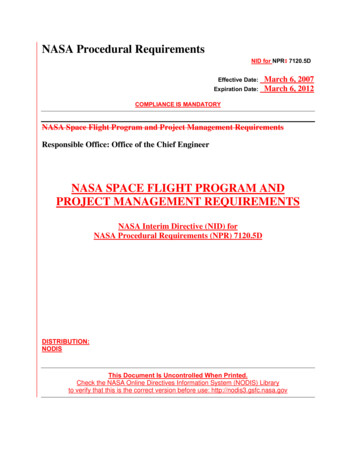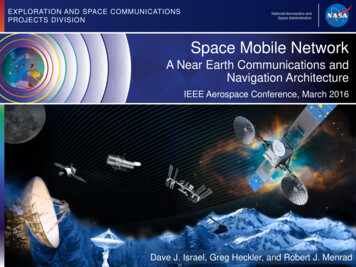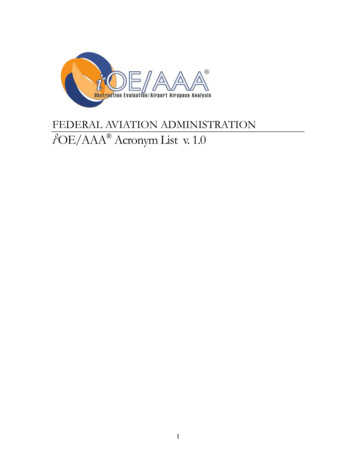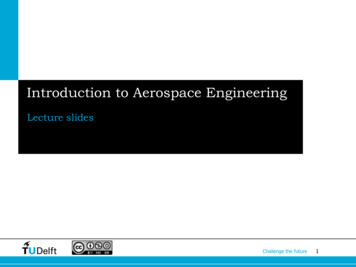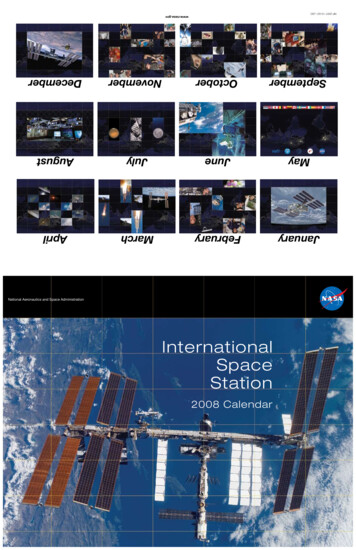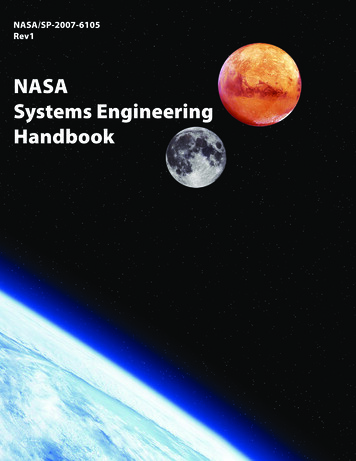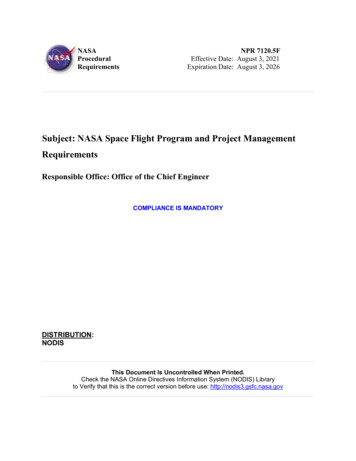
Transcription
NASAProceduralRequirementsNPR 7120.5FEffective Date: August 3, 2021Expiration Date: August 3, 2026Subject: NASA Space Flight Program and Project ManagementRequirementsResponsible Office: Office of the Chief EngineerCOMPLIANCE IS MANDATORYDISTRIBUTION:NODISThis Document Is Uncontrolled When Printed.Check the NASA Online Directives Information System (NODIS) Libraryto Verify that this is the correct version before use: http://nodis3.gsfc.nasa.gov
NPR 7120.5ii
Table of ContentsPrefaceP.1 PurposeP.2 ApplicabilityP.3 AuthorityP.4 Applicablcable Documents and FormsP.5 Measurement/VerificationP.6 CancellationChapter 1. Introduction1.11.21.31.41.5Key Policy Changes to NPR 7120.5 Revision F Since Revision EBackgroundOverview of Management ProcessAcquisitionDocument StructureChapter 2. NASA Life Cycles for Space Flight Programs and Projects2.12.22.32.4Programs and ProjectsProgram and Project Life CyclesProgram and Project Oversight and ApprovalApproving and Maintaining Program and Project Plans, Baselines, and CommitmentsChapter 3. Program and Project Management Roles and es and ResponsibilitiesTechnical AuthorityProcess for Handling Formal DissentPrinciples Related to Tailoring RequirementsReimbursable Space Flight WorkUse of the Metric SystemAppendix A. DefinitionsAppendix B. AcronymsAppendix C. Compliance Matrix and Tailoring Guidance and ResourcesAppendix D. Program Commitment Agreement TemplateD.1 PCA Title PageD.2 PCA TemplateAppendix E. Formulation Authorization Document Template
E.1 Program FAD Title PageE.2 Project FAD Title PageE.3 Program/Project FAD TemplateAppendix F. Project Formulation Agreement TemplateF.1 Formulation Agreement Template InstructionsF.2 Formulation Agreement Title PageAppendix G. Program Plan TemplateG.1 Template InstructionsG.2 Program Plan Title PageG.3 Program Plan TemplateAppendix H. Project Plan TemplateH.1 Template InstructionsH.2 Project Plan Title PageH.3 Project Plan TemplateAppendix I. Program and Project Products by PhaseAppendix J. ReferencesNPR 7120.5ii
LIST OF TABLESTable 1-1 Programmatic Requirements HierarchyTable 2-1 Project Categorization GuidelinesTable 2-2 Convening Authorities for Standing Review BoardTable 2-3 Expected Maturity State Through the Life Cycle of Uncoupled and Loosely CoupledProgramsTable 2-4 Expected Maturity State Through the Life Cycle of Tightly Coupled ProgramsTable 2-5 Expected Maturity State Through the Life Cycle of Projects and Single-ProjectProgramsTable 2-6 Objectives for Other ReviewsTable C-1 Compliance MatrixTable D-1 Sample Program Commitment Agreement Activities LogTable I-1 Uncoupled and Loosely Coupled Program Milestone Products and Control PlansMaturity MatrixTable I-2 Tightly Coupled Program Milestone Products Maturity MatrixTable I-3 Tightly Coupled Program Plan Control Plans Maturity MatrixTable I-4 Project Milestone Products Maturity MatrixTable I-5 Project Plan Control Plans Maturity MatrixTable I-6 Single-Project Program Milestone Products Maturity MatrixTable I-7 Single-Project Program Plan Control Plans Maturity MatrixNPR 7120.5iii
LIST OF FIGURESFigure 1-1 Institutional Requirements Flow DownFigure 2-1 Programmatic Authority Organizational HierarchyFigure 2-2 NASA Uncoupled and Loosely Coupled Program Life CycleFigure 2-3 NASA Tightly Coupled Program Life CycleFigure 2-4 NASA Single-Project Program Life CycleFigure 2-5 NASA Project Life CycleFigure 2-6 Example of Agreements and Commitments in Terms of Cost for ProjectsFigure D-1 Program Commitment Agreement Title PageFigure E-1 Program Formulation Authorization Document Title PageFigure E-2 Project Formulation Authorization Document Title PageFigure F-1 Formulation Agreement Title PageFigure G-1 Program Plan Title PageFigure H-1 Project Plan Title PageFigure H-2 Standard Level 2 WBS Elements for Space Flight ProjectsNPR 7120.5iv
PREFACEP.1 PURPOSEThis document establishes the requirements by which NASA formulates and implements spaceflight programs and projects, consistent with the governance model contained in NASA PolicyDirective (NPD) 1000.0, NASA Governance and Strategic Management Handbook.P.2 APPLICABILITYa. This NASA Procedural Requirements (NPR) is applicable to NASA Headquarters (HQ) andNASA Centers, including Component Facilities and Technical and Service Support Centers.This language applies to the Jet Propulsion Laboratory (a Federally Funded Research andDevelopment Center), other contractors and recipients of grants, cooperative agreements, orother agreements, only to the extent specified or referenced in the applicable contracts, grants, oragreements.b. This NPR applies to all NASA space flight programs and projects including spacecraft,launch vehicles, instruments developed for space flight programs and projects, some researchand technology (R&T) developments1 funded by and to be incorporated into space flight oraeronautics programs and projects, technical facilities specifically developed or significantlymodified for space flight systems, Information Technology (IT) acquired as a part of space flightprograms and projects, and ground systems that are in direct support of space flight operations.This NPR also applies to reimbursable space flight programs and projects performed for nonNASA sponsors and to NASA contributions to space flight programs and projects performedwith international and interagency partners.c. For existing programs and projects, the Revision F changes to the requirements of this NPRapply to their current and future phases as determined by the responsible Mission Directorate andconcurred with by the NASA Chief Engineer (or as delegated) and the Decision Authority.d. This NPR can be applied to other NASA investments at the discretion of the responsiblemanager or the NASA Associate Administrator.e. In this directive, all mandatory actions (i.e., requirements) are denoted by statementscontaining the term “shall.” The terms “may” or “can” denote discretionary privilege orpermission, “should” denotes a good practice and is recommended but not required, “will”denotes expected outcome, and “are/is” denotes descriptive material.f. In this directive, all document citations are assumed to be the latest version unless otherwisenoted. Documents cited as authority, applicable, or reference documents may be cited as adifferent categorization, which characterizes its function in relation to the specific context.1R&T programs and projects that are directly funded by a space flight program/project should decide whether theyare subject to NPR 7120.5, NPR 7120.8, or will be a hybrid between those two per Mission Directorate policy andDecision Authority (DA) approval. R&T projects that directly tie to the space flight mission’s success and scheduleare normally managed under NPR 7120.5.NPR 7120.51
P.3 AUTHORITYa. The National Aeronautics and Space Act, as amended, 51 U.S.C. § 20113(a).b. NPD 1000.0, NASA Governance and Strategic Management Handbook.c. NPD 1000.3, The NASA Organization.d. NPD 1000.5, Policy for NASA Acquisition.e. NPD 1001.0, NASA Strategic Plan.f. NPD 7120.4, NASA Engineering and Program/Project Management Policy.P.4 APPLICABLE DOCUMENTS AND FORMSa. NASA Federal Acquisition Regulation (FAR) Supplement (NFS), 48 Code of FederalRegulation (CFR), Chapter 18.b. NPD 7500.1, Program and Project Life-Cycle Logistics Support Policy.c. NPD 8020.7, Biological Contamination Control for Outbound and Inbound PlanetarySpacecraft.d. NPR 1040.1, NASA Continuity of Operations (COOP) Planning Procedural Requirements.e. NPR 1058.1, NASA Enterprise Protection Program.f. NPR 1600.1, NASA Security Program Procedural Requirements.g. NPR 2190.1, NASA Export Control Program.h. NPR 2810.1, Security of Information Technology.i. NPR 7120.10, Technical Standards for NASA Programs and Projects.j. NPR 7123.1, NASA Systems Engineering Processes and Requirements.k. NPR 7150.2, NASA Software Engineering Requirements.l. NPR 8000.4, Agency Risk Management Procedural Requirements.m. NPR 8020.12, Planetary Protection Provisions for Robotic Extraterrestrial Missions.n. NPR 8580.1, Implementing the National Environmental Policy Act and Executive Order12114.o. NPR 8600.1, NASA Capability Portfolio Management Requirements.p. NPR 8705.2, Human-Rating Requirements for Space Systems.q. NPR 8705.4, Risk Classification for NASA Payloads.r. NID 7120.132, Collision Avoidance for Space Environment Protection.https://nodis3.gsfc.nasa.gov/OPD docs/NID 7120 132 .pdfs. NASA/SP-2016-3706, NASA Standing Review Board 30t. EIA-748, Standard for Earned Value Management Systems.NPR 7120.52
P.5 MEASUREMENT/VERIFICATIONa. Compliance with this document is verified by submitting the gate products identified in thisdocument at Key Decision Points (KDPs) to responsible NASA officials and milestone productsand control plans due at life-cycle reviews (LCRs) and by internal and external controls. Internalcontrols are consistent with processes per NPD 1200.1, NASA Internal Control. Internalcontrols include surveys, audits, and reviews conducted in accordance with NPD 1210.2, NASASurveys, Audits, and Reviews Policy. External controls may include external surveys, audits,and reporting requirements.b. Compliance is also documented by appending a completed Compliance Matrix for this NPR(see Appendix C) to the Formulation Agreement for projects in Formulation and/or the ProgramPlan or Project Plan (see appendices G or H) for programs or projects entering or inImplementation. A copy of the Compliance Matrix is forwarded to the Office of the ChiefEngineer. Organizations with authority to approve waivers or deviations to specificrequirements are specified in Appendix C, Table C-1, Compliance Matrix.P.6 CANCELLATIONa. NPR 7120.5E, NASA Space Flight Program and Project Management Requirements, datedAugust 14, 2012.b. NID 7120.130, NASA Space Flight Program and Project Management Requirements - SpaceSystems Protection Standard Update.c. NID 7120.122, Joint Cost and Schedule Confidence Level (JCL) Requirements Updates.NPR 7120.53
Chapter 1. Introduction1.1Key Policy Changes to NPR 7120.5 Revision F Since Revision E1.1.1 Key policy changes in NPR 7120.5F, NASA Space Flight Program and ProjectManagement Requirements, include updating the requirements for establishing Agency BaselineCommitments (ABC) and for performing Joint Cost and Schedule Confidence Level (JCL)analyses for tightly coupled programs, adding additional requirements for doing a JCL analysisfor single-project programs and projects over 1B life-cycle cost (LCC), and using initialcapability cost estimates instead of LCC estimates in specific, identified instances for singleproject programs and projects that plan continuing operations and production, includingintegration of capability upgrades, with an unspecified Phase E end point.1.1.2 Per NPD 1000.0, NASA Governance and Strategic Management Handbook, tailoring isboth accepted and expected. Tailoring guidance has been added to Appendix C along with areference to a tailoring Web site that includes resources to facilitate tailoring the requirements inthis NPR. Changes to tailoring guidance include clarifying the process for assigning “nonapplicable” to requirements and modifying stand-alone requirements for program and projectcontrol plans; flexibility for programs using innovative acquisition approaches; clarification ofdelegation of tailoring authority; and pre-customization of the NPR 7120.5 Compliance Matrix.Requirements for tailoring are in Section 3.5.1.1.3 With the release of the NASA-STD-1006, Space System Protection Standard and NPR1058.1, NASA Enterprise Protection Program, Space Asset Protection is now the MissionResiliency and Protection Program. Programs are no longer required to do a Threat Summary,and Project Protection Plans need to address the new standard and NPR.1.1.4 Changes related to governance include updates to program and project acquisitionstrategy and planning aligned with NPD 1000.5, Policy for NASA Acquisition; shiftedresponsibility for management of independent reviews from the Independent ProgramAssessment Office to Mission Directorates; and added program and project consideration formanagement and utilization of Agency-level capability components through capability portfoliosper NPR 8600.1, NASA Capability Portfolio Management Requirements. The DissentingOpinion process is now the Formal Dissent process, which retains the current process augmentedwith an expedited escalation path.1.1.5 Changes to the life cycle include clarification of the criteria triggering a ProgramImplementation Review (PIR), adding emphasis to the use of Leading Indicators in life-cyclereviews (LCRs) and Key Decision Points (KDPs), and providing additional guidance in theNASA Common Leading Indicators Detailed Reference Guide athttps://nodis3.gsfc.nasa.gov/OCE rep/OCE list.cfm.1.1.6 Updates to program and project documentation and guidance include changes to theAppendix I table documentation and products developed during the life cycle. This includes theaddition of the Human Systems Integration Plan, System Security Plan, Quality AssuranceSurveillance Plan, Orbital Collision Avoidance Plan, and Performance Measurement Baselineand the deletion of the Education Plan, Information Technology Plan, and Product Data and LifeNPR 7120.54
Cycle Management Plan. In addition, this NPR adds reference to NASA/SP-2016-3424, NASAProject Planning and Control Handbook.1.2Background1.2.1 NASA space flight programs and projects develop and operate a wide variety ofspacecraft, launch vehicles, in-space facilities, communications networks, instruments, andsupporting ground systems.2 This document establishes a standard of uniformity for the processby which NASA formulates and implements space flight programs and projects.1.2.2 NASA approaches the formulation and implementation of programs and projects througha governance model that balances different perspectives from different elements of theorganization. The cornerstone of program and project governance is the organizationalseparation of the Programmatic Authorities from the Institutional Authorities. TheProgrammatic Authorities include the Mission Directorates and their respective programs andprojects. The Institutional Authorities include the Mission Support Directorate and other missionsupport offices (e.g., engineering, safety and mission assurance, information technology,procurement, and health and medical) and Center Directors and Center organizations that alignwith these mission support offices. (See NPD 1000.0, NASA Governance and StrategicManagement Handbook and NASA/SP-2014-3705, NASA Space Flight Program and ProjectManagement Handbook.)1.2.3 This NPR distinguishes between “programmatic requirements” and “institutionalrequirements.” Both categories of requirements ultimately need to be satisfied in program andproject Formulation and Implementation.1.2.3.1 Programmatic requirements are the responsibility of the Programmatic Authorities.Programmatic requirements focus on the products to be developed and delivered and specificallyrelate to the goals and objectives of a particular NASA program or project. These programmaticrequirements flow down from the Agency’s strategic planning process. Table 1-1 shows thisflow down from Agency strategic planning through Agency, directorate, program, and projectrequirement levels to the systems that will be implemented to achieve the Agency goals.2NASA space flight programs and projects often need to mature technologies to meet mission goals. These enablingand/or enhancing technologies are also covered by this NPR, insofar as developments of those technologies applyper Section P.2(b) above.NPR 7120.55
Table 1-1 Programmatic Requirements HierarchyRequirementsLevelContentGoverning Document ApproverOriginatorNASAStrategicGoalsAgency goals, objectives, andstrategic directionNPD 1001.0, NASAStrategic Plan; andStrategic eRequirementsHigh-level requirements levied ona program to carry out strategicand architectural direction,including programmatic directionfor initiating specific projectsProgram CommitmentAgreement (PCA)NASA AA MDAAProgramRequirementsDetailed requirements levied on aprogram to implement the PCAand high-level programmaticrequirements allocated from theprogram to its projectsProgram PlanMDAAProgramManagerProjectRequirementsDetailed requirements levied on aproject to implement the ProgramPlan and flow down programmaticrequirements allocated from theprogram to the projectProject Detailed requirements allocatedfrom the project to the next lowerlevel of the projectSystem System LeadOCFOMDAA Mission Directorate Associate Administrator; NASA AA NASA Associate Administrator1.2.3.2 Institutional requirements are the responsibility of the Institutional Authorities. (SeeSection 3.3 for details on Technical Authority.) Institutional requirements focus on how NASAdoes business and are independent of any particular program or project. These requirements areissued by NASA HQ (including the Office of the Administrator, Mission Support Directorate,and other mission support offices) and by Center organizations. Institutional requirements mayrespond to Federal and State statute, regulation, treaty, or Executive Order. They are normallydocumented in NPDs, NPRs, NASA Standards, Center Policy Directives Center ProceduralRequirements, and Mission Directorate requirements.1.2.4 This NPR is focused on improving program and project performance against internal andexternal commitments. Figure 1-1 shows the flow down from NPD 1000.0, NASA Governanceand Strategic Management Handbook through Program and Project Plans. The figure identifiesthe five types of institutional requirements that flow down to these plans: engineering,program/project management, safety and mission assurance, health and medical, and missionsupport requirements. These terms are defined in Appendix A.NPR 7120.56
NPD 1000.0NPD 1000.3NPD 1000.5NPD 7120.4Engineeringand RelatedDirectivesNPD 8700.1Program and ProjectManagementDirectivesEngineering RequirementsOSMADirectivesSafety and entRequirementsNPD 8900.1OCHMODirectivesHealth and onDirectivesMission SupportRequirementsCenter Engineeringand ManagementPolicies andPracticesMission DirectorateProgrammaticRequirementsProgram andProject PlansFigure 1-1 Institutional Requirements Flow Down1.3Overview of Management Process1.3.1 Although this document emphasizes program and project management based on lifecycles, Key Decision Points (KDPs), and evolving programmatic products during each life-cyclephase, these elements are embedded in NASA’s four-part process for managing programs andprojects, which consists of:a. Formulation—identifying how the program or project supports the Agency’s strategic goals;assessing feasibility, technology, and concepts; performing trade studies; assessing and possiblymitigating risks based on risk-informed decision making (RIDM) and continuous riskmanagement (CRM) processes; maturing technologies; building teams; developing system-levelpreliminary designs; developing operations concepts and acquisition strategies; establishinghigh-level requirements, requirements flow down, and success criteria; assessing the relevantindustrial base/supply chain to ensure program or project success; preparing plans, costestimates, budget submissions, and schedules essential to the success of a program or project;and establishing control systems to ensure performance of those plans and alignment withcurrent Agency strategies.NPR 7120.57
b. Approval (for Implementation)—acknowledgment by the Decision Authority (see AppendixA for definition of “Decision Authority”) that the program/project has met Formulationrequirements and is ready to proceed to Implementation. By approving a program/project, theDecision Authority commits to the time-phased cost plan based on technical scope and schedulenecessary to continue into Implementation.c. Implementation—execution of approved plans for the development and operation of theprogram/project and use of control systems to ensure performance to approved plans andrequirements and continued alignment with the Agency’s strategic goals.d. Evaluation—continual self and independent assessment of the performance of a program orproject and incorporation of the assessment findings to ensure adequacy of planning andexecution according to approved plans and requirements.1.4Acquisition1.4.1 NASA’s program and project support of its overall mission is long term in nature, but theenvironment in which these programs and projects are conducted is dynamic. In recognition ofthis, NPD 1000.0, NASA Governance and Strategic Management Handbook and NPD 1000.5,Policy for NASA Acquisition have put in place a framework for ensuring that NASA’s strategicvision, programs and projects, and resources remain properly aligned. The acquisition processand annual strategic resource planning form a continuous process to oversee this alignment. Inaddition, the Agency’s senior Acquisition Strategy Council (ASC) makes decisions regardingstrategic resource planning, specific acquisition strategy approval, and acquisition policyintegration and performance.1.4.2 All programs and projects implement acquisitions consistent with NPD 1000.5, Policy forNASA Acquisition. At the program and project level, the Pre-Acquisition Strategy Meeting(Pre-ASM), the Acquisition Strategy Meeting (ASM), and the Procurement Strategy Meeting(PSM) support the Agency’s acquisition process, which includes strategic planning as well asprocurement. Information on Pre-ASMs and ASMs, the associated convening authorities, andcriteria for determining the convening authority is provided in NPD 1000.5, Policy for NASAAcquisition and its NASA Advisory Implementing Instructions. The PSM is described in NASAFAR Supplement (NFS) 1807.170-71. The PSM guide may be accessed ared Documents/Forms/AgencyWideProcurement Templates.aspx?id %2Fsites%2Fprocurement%2FShared Documents%2FNASAPSM Guide%2Epdf&parent %2Fsites%2Fprocurement%2FShared Documents or by contactingthe Office of Procurement.1.5Document Structure1.5.1 Chapter 2 defines the different types of programs and projects, their documents, and howthey mature through their different life cycles. It also describes how to establish baselines andapproval processes. Chapter 3 describes roles and responsibilities relevant to program andproject managers, the governance structure, Technical Authority (TA), the dissent process, andhow to tailor requirements. Appendix C contains the Compliance Matrix and tailoring guidanceand resources. Templates for required program and project documents are contained inNPR 7120.58
appendices D through H. Appendix I encompasses the tables of program and project products byphase. Appendix J provides a list of references.1.5.2 The companion handbook to this NPR, NASA/SP-2014-3705, NASA Space FlightProgram and Project Management Handbook, describes how programs and projects are managedin NASA and contains explanatory material and context to help understand the requirements ofthis NPR and how to implement them. In addition, NASA/SP-2016-3706, NASA StandingReview Board Handbook is closely aligned to this NPR and provides guidance for the planning,preparation, review, reporting, and closeout of Standing Review Board (SRB) activities. TheseHandbooks can be found on the “Other NASA-Level Documents” menu in the NASA OnlineDirectives Information System (NODIS) under the tab for the Office of the Chief Engineer(OCE).NPR 7120.59
Chapter 2. NASA Life Cycles for Space Flight Programs andProjects2.1Programs and Projects2.1.1 Space flight programs and projects flow from the implementation of national priorities,defined in the Agency’s Strategic Plan, through the Agency’s Mission Directorates, as part of theAgency’s general work breakdown hierarchy shown in Figure 2-1.MissionDirectoratesProgramsProjectsFigure 2-1 Programmatic Authority Organizational Hierarchy2.1.1.1 This hierarchical relationship of programs to projects shows that programs and projectsare different, and their management involves different activities and focus. Programs andprojects are distinguished by the following characteristics.a. Program—Programs are a strategic investment by Mission Directorates or mission supportoffices with a defined architecture and/or technical approach, requirements, funding level, and amanagement structure that initiates and directs one or more projects. A program implements astrategic direction that the Agency has identified as needed to accomplish Agency goals andobjectives.b. Project—Space flight projects are a specific investment identified in a Program Plan havingdefined requirements, a life-cycle cost, a beginning, and an end. A project also has amanagement structure and may have interfaces to other projects, agencies, and internationalpartners. A project yields new or revised products that directly address NASA’s strategic goals.2.1.1.2 Regardless of the structure of a program or project meeting the criteria of Section P.2,this NPR shall apply to the full scope of the program or project and all the activities under it.Specific NPR 7120.5 requirements are flowed down to these activities to the extent necessary forthe program or project to ensure compliance and mission success. See Section 3.5.6.1 for theprocess of obtaining any required deviations or waivers.2.1.2NASA Programs2.1.2.1 NASA space flight programs are initiated and implemented to accomplish scientific orexploration goals that generally require a collection of mutually supporting projects. Programsintegrate and manage these projects over time and provide on-going enabling systems, activities,methods, technology developments, and feedback to projects and stakeholders. Programs areNPR 7120.510
generally created by a Mission Directorate with a long-term horizon in mind, though as theAgency’s strategic direction or circumstances change, a Mission Directorate occasionally needsto replan its programs or combine related programs to increase effectiveness. Programs aregenerally executed at NASA Centers under the direction of the Mission Directorate and areassigned to Centers based on decisions made by Agency senior management consistent with theresults of the Agency’s strategic acquisition planning process. Because the scientific andexploration goals of programs vary significantly, different program implementation strategies arerequired, ranging from simple to complex. To accommodate these differences, NASA identifiesfour basic types of programs (described below and defined in Appendix A) that may beemployed: single-project programs, uncoupled programs, loosely coupled programs, and tightlycoupled programs. Characteristics of the program types are:a. Single-Project: These programs (e.g., James Webb Space Telescope) tend to have longdevelopment and operational lifetimes and represent a large investment of Agency resources.Multiple organizations or agencies contribute to them. Single-project programs have one projectand implement their program objectives and requirements through one of two managementapproaches: (1) separate program and project structures or (2) a combined structure. Therequirements for both programs and projects apply to single-project programs as described in thisNPR.b. Uncoupled: These programs (e.g., Discovery Program) are implemented under a broadtheme (like planetary science) and/or a common program implementation mechanism, such asproviding flight opportunities for formally competed cost-capped projects or PrincipalInvestigator (PI)-led missions and investigations. Each project in an uncoupled program isindependent of the other projects within the program.c. Loosely Coupled: These programs (e.g., Mars Exploration Program) address specificobjectives through multiple space flight projects of varied scope. While each project has anindependent set of mission objectives, the projects as a whole have architectural andtechnological synergies and strategies that benefit the program. For example, Mars orbitersdesigned for more than one Mars year in orbit are required to carry a communication system tosupport present and future landers.d. Tightly Coupled: These programs have multiple projects that execute portions of a missionor missions. No single project is capable of implementing a complete mission. Typically,multiple NASA Centers contribute to the program. Individual projects may be managed atdifferent Centers. The program may also include other agency or international partnercontributions.2.1.3NASA Projects2.1.3.1 As with programs, projects vary in scope and complexity and thus require varyinglevels of management requirements and Agency attention and oversight. Consequently, projectcategorization defines Agency expectations of project managers by determining both theoversight council and the specific approval requirements. Projects are Category 1, 2, or 3 andNPR 7120.511
shall be assigned to a category based initially on: (1) the project life-cycle cost (LCC) estimate,the inclusion of significant radioactive material3, and whether or not the system being developedis for human space flight; and (2) the priority level, which is related to the importance of theactivity to NASA, the extent of international participation (or joint effort with other governmentagencies), the degree of uncertainty surrounding the application of new or untested technologies,and spacecraft/payload development risk classification. (See NPR 8705.4, Risk Classificationfor NASA Payloads.) Guidelines for determ
a. NPR 7120.5E, NASA Space Flight Program and Project Management Requirements, dated August 14, 2012. b. NID 7120.130, NASA Space Flight Program and Project Management Requirements - Space Systems Protection Standard Update. c. NID 7120.122, Joint Cost and Schedule Confidence Level (JCL) Requirements Updates.
